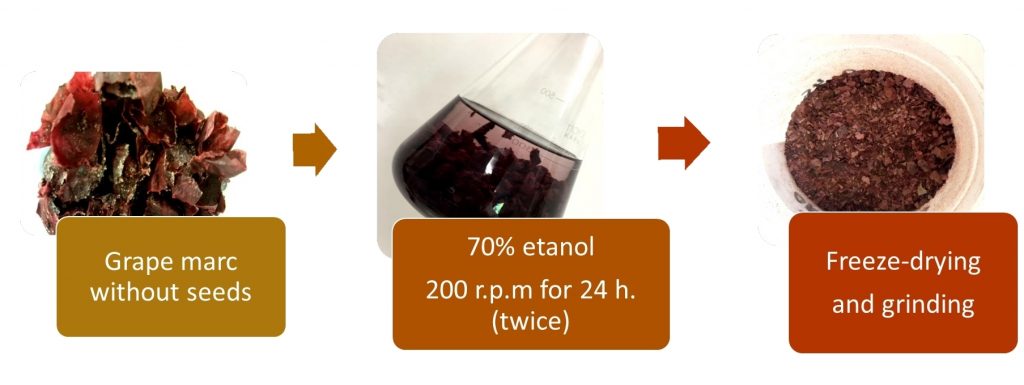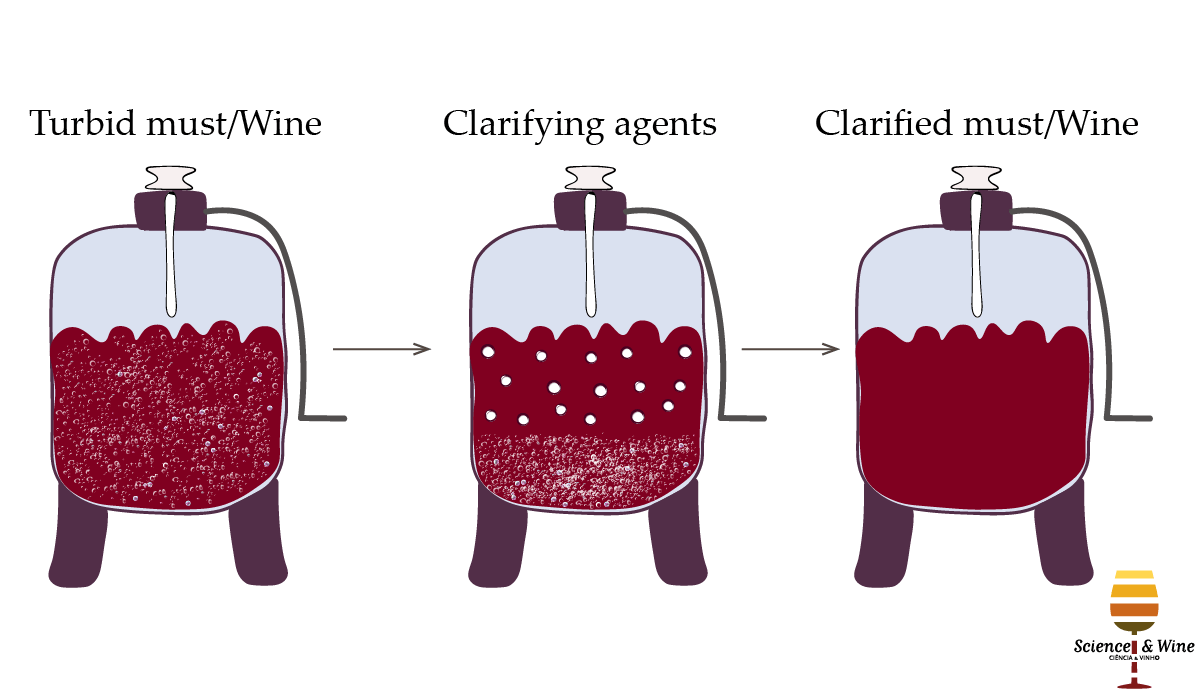By Encarna Gómez-Plaza
Fining is a winemaking technique used to remove unwanted wine components that affect clarification, astringency, color, bitterness, aroma and even safety of the wine. One of the objectives of fining is often to reduce the wine tannin content due to its effect on wine astringency. Proteinaceous agents are commonly used with this objective, but they may present problems related with their possible allergenic properties. The EU Directive 2007/68/EC (November 27, 2007) indicates the legal obligation to indicate their presence on the label, a fact that may reduce their attraction for consumers. Moreover, some strict vegetarians, such as vegans, do not accept any beverage treated with products of animal origin and these are the main reasons why fining agents of vegetal origin have become more popular as substitutes of animal-origin potentially allergenic proteins. But proteinaceous fining agents may cause an excessive enrichment of wine with proteins, which may cause stability and turbidity problems. This has led to the search for new fining agents. In this way, the cell wall material from processed grape pomace, or the direct use of purified grape pomace could be a good alternative.

We have been working for the last two years with this material. Our results showed that, at laboratory scale, pomace cell walls have a fining effect that exceeds that of most the protein-based fining agents, even when used at their highest recommended doses. The cell wall material significantly reduced the wine phenolic content, the reduction ranging from 48 to 68% for anthocyanins and from 44 to 64% for tannins. The pomace cell walls exhibited such a high capacity that they should be used at much lower doses than those used in our study and reducing the dose we will also reduce the formation of lees and the wine adsorbed on them (Jimenez-Martínez et al., 2017).
However, the obtention of purified cell walls is a laborious and tedious work so we tried to word with a much simpler purification of the pomace. When instead of cell walls, purified pomace was used, we could observe that tannins were also reduce, a positive effect may result in decreasing astringency in the wine, although a slight decrease in the wine color also take place since the anthocyanins are also retained by this material and that may affect the wine quality. These problems of color retention can be limited reducing the dose of purified grape pomace and the contact time. Our studies showed that a dose of 6 mg/ml and a contact time of 5 days could be suitable for decreasing the wine tannin content without producing great changes in the wine chromatic characteristics. The level of tannin reduction can be similar to those observed by different commercial products (Jiménez-Martínez, 2018).

We have also worked with purified grape pomace (PGP) from different varieties and the size exclusion chromatography (SEC) analysis allowed us to observe the variations in the molecular size of the phenolic compounds of the wine after the fining treatment with PGP, which would affect the attributes of the wine (mouthfeel, bitterness, astringency and the concentration of stable polymeric pigments in wine), observing how these phenolic compounds were affected, especially the compounds of high molecular weight, which are related to astringency and bitterness although it was found that PGP also reduced low molecular mass tannin.
The quality of red wine also depends on the absence of compounds which may affect its safety and/or stability such as ochratoxin A, biogenic amines and some metals and trace compounds. The presence of ochratoxin A in musts and wines is due to fungal contamination of the grapes and has been classified as a possible human carcinogen. Biogenic amines are formed by the microbiological decarboxylation of the corresponding amino acid precursors during the fermentation or aging and storage, and, at high concentrations, they may induce adverse reactions in sensitive people. Trace elements may have both a nutritional and a toxic effect on health, but also can cause turbidity and stability problems. One of the best options to remove these compounds when present in excess in wine is fining. We studied if this material can limit the presence of ochratoxin A, biogenic amines and metals and some trace elements in a red wine, thus increasing the value and safety of this product. Purified grape pomace led to very good results, and resulted in a significant reduction of OTA, histamine and of K and Ca, which could lead to a reduction in tartrate instability (Jiménez-Martínez et al., 2018).

Therefore, this material could be a good alternative for protein-based fining agents in red wine, as they are insoluble, relatively inert, polysaccharide-based, and may also reduce turbidity problems and can be used to reduce tannins and contaminants such as OTA and BA. Also, a reduction of K and Ca could be of interest. Moreover, their use would avoid allergen-related effects. Lastly, the use of pomace CW material as a fining agent could increase the added value of this byproduct, which is currently very low and very abundant in wineries. Grape pomace is one of the most abundant and valuable winery by-products. Recent OIV statistics have pointed to a worldwide production of grapes of 75.8 million tons, of which 35.62 million are destined for wine production while 30% of this last weight results in byproducts (OIV World Vitiviniculture Situation, 2017). The main byproduct is grape pomace (seeds, skin, and peduncle), and its valorization is considered an important issue. In a wider context, regulations are being focused to make the food chain in the EU more efficient and the development of new alternative uses for unavoidable wastes is actively encouraged (Opinion of the European Economic and Social Committee on ‘Civil society’s contribution to a strategy for prevention and reduction of food losses and food waste’, EC 2013/C 161/08).


Those interested in a longer length report can download the working paper at:
https://www.tandfonline.com/doi/abs/10.1080/19440049.2018.1459050

Encarna Gómez-Plaza studied chemistry at University of Murcia (Spain). She did her Ph.D. in 1992 on the study of the volatile components of grapes and wines. She was hired by the Agricultural Research Service and the California Raisin Advisory Board in Fresno (California) to carry out a research project on the presence of trichloroanisoles in raisins. She returned to Spain with a reincorporation contract for doctors and technicians and for three years she continued working on grapes and wines, focusing on the polyphenolic and chromatic characterization of red wines. She joined Professor J.M. López-Roca team in January 1998 as an Assistant Professor in Food Technology at the University of Murcia. She is a full time Professor in this University since 2007.
She has participated in numerous research projects with regional and national funding on the study of grapes and wines. Currently, her research area focuses mainly, although not exclusively, on the study of the chromatic characteristics of grapes and wines and in the interaction of phenolic compounds and polysaccharides and the impact these interactions may have in wine quality. She is the author of numerous scientific publications in both popular and high impact scientific journals and reviewer of some of the best journals scientific food technology.
References
- Jiménez-Martínez,M.D., Gómez-Plaza, E., Molero, N., & Bautista-Ortin, A. B. (2017). Fining of red wines with pomace cell wall material: Effect on wine phenolic composition. Food and Bioprocess Technology, 10, 1531-1539.
- Jimenez-Martínez, M.D. Possibilidades tecnológicas de las paredes celulares de los orujos de uva como agentes afinantes durante la vinificación. Ph.D. Thesis, University of Murcia.
- Jiménez-Martínez,M.D., Gil-Muñoz, R., Gómez-Plaza, E., & Bautista-Ortin, A. B. (2018). Performance of purified grape pomace as a fining agent to reduce the levels of some contaminants from wine. Food Additives and Contanimants, On line first, https://doi.org/10.1080/19440049.2018.1459050

